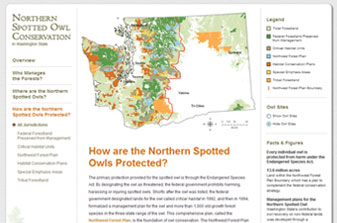New Challenges to Northern Spotted Owl Recovery
Private landowner's best efforts at habitat protection challenged by Barred Owls and wildfire
While private forest landowners protect Northern Spotted Owls on their
lands, and conduct research to better understand the relationship
between the owls and their habitat, new challenges have arisen which
threaten the species. The aggressive Barred Owl, a competitor species,
has invaded Spotted Owl habitat. In addition, unusually hot
wildfires that have occurred in forests with poor health have burned
owl habitat.
Earlier this year environmental groups made a legal challenge to the
state forest practices rules governing spotted owl habitat in federal
court, the judge refused to enjoin harvest permitted through the state
forest practices system.
Judge refuses to enjoin harvest permitted through the state
forest practice system in response to environmental
group challenge.

The Northern Spotted Owl has long been a symbol in Pacific Northwest
forests of the need to protect our state’s old growth ecosystems.
Listed as “threatened” in 1990 under the Endangered Species Act, forest
policy and practices dramatically changed across the three state range
of the owl in California, Oregon and Washington. Timber harvesting was
reduced more than 80% across 24 million acres of federal forest to
provide a connected system of habitat supporting late successional
old growth species.
Forest policy changes led to a reduction in timber harvesting due to
implementation of the federal Northwest Forest Plan, private and state Habitat
Conservation Plans and in Washington, forest practices regulations were
changed to complement the federal conservation strategy, which adds up
to nearly 14 million acres of land in Washington alone.



